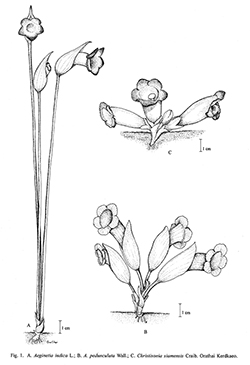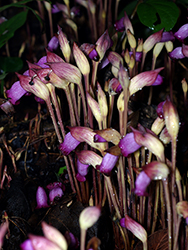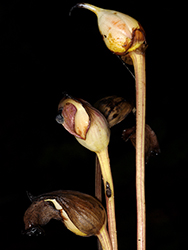e-Flora of Thailand
Volume 9 > Part 2 > Year 2008 > Page 144 > Orobanchaceae > Aeginetia
1. Aeginetia indica L.wfo-0000521508
Sp. Pl. 2: 632. 1753; Roxb., Pl. Comoron. 1: 63. t. 91. 1798 & Fl. Ind. ed. 2, 3: 30. 1832; Wight, Icon. Pl. Ind. Or. t. 895. 1844–1845; Ramamoorthy in Salandanha & Nicolson, Fl. Hassan Distr. 532. 1976; Philcox in Dassan. & Clayton, Rev. Handb. Fl. Ceylon 11: 372. 1997.— A. indica Roxb. In Hook.f., Fl. Brit. Ind. 4: 320. 1885; Craib in Kerr, Fl. Siam. Enum. 3: 194. 1951.— A. indica (L.) Roxb., P.H.Hô, Câyco Viêtnam 3: 1. 1992 (drawing not of A. indica but of A. peduculata). Fig. 1: A; Plate XIV: 1.
Accepted Name : This is currently accepted.
Synonyms & Citations :
Description : Stems all flowering, solitary, 10–35(–40 cm) cm high; yellowish, brownish or reddish to maroon; often red striped. Flowers solitary; buds ellipsoid. Calyx 2.5–3.5 cm long, the tip erect to recurved; purplish, pinkish, rarely whitish; often glossy. Corolla ca 2–3(–4) cm long; ca 1.5–2 cm of tube exserted beyond calyx, exserted portion of tube weakly curved or ± straight, usually purplish to maroon on outside, occasionally whitish; lower portion of concealed part of tube strongly flexed, often ± geniculate, forming a narrow throat above the ovary; lobes ca 2 mm long, rounded, not denticulate, little-spreading; usually purplish to maroon on both surfaces, occasionally whitish externally and purple to maroon on the interior face; glossy externally. Stamens included, attached ± at point of inflexion of corolla tube; point of attachment hairless. Style yellow or whitish-pink, curved; stigma yellow or whitish-pink, included. Capsule ca 2.5 cm, dehiscent by rotting of the walls.
Thailand : NORTHERN: Mae Hong Son, Chiang Mai, Chiang Rai, Nan, Lamphun, Lampang, Phrae, Tak, Sukhothai; NORTH-EASTERN: Phetchabun, Loei, Sakhon Nakhon, Khon Kaen; EASTERN: Chaiyaphum, Nakhon Ratchasima, Surin, Ubon Ratchathani; SOUTH-WESTERN: Kanchanaburi; CENTRAL: Chai Nat, Saraburi; SOUTH-EASTERN: Chon Buri, Chanthaburi, Trat; PENINSULAR: Surat Thani, Phangnga, Trang.
Distribution : India, Sri Lanka, Burma, Vietnam, Malay Peninsula, Java, China, the Philippines, Borneo, New Guinea, Japan.
Ecology : Mainly in hill evergreen, bamboo, dipterocarp and pine forests but also in other forests types and by roadsides, on granite or limestone substrata, 0–1,600 m alt.
Vernacular : So-suai (ซอซวย)(Karen-Mae Hong Son); ya dok kho (หญ้าดอกขอ)(Loei); dok din daeng (ดอกดินแดง)(Trat); pak cha khe (ปากจะเข้)(Northeastern); sop laeng (สบแล้ง)(Songkhla).
Uses: Whole plant powdered and used for cankerous wounds. Also used in New Guinea to alleviate knee pain (by striking) and used similarly to help small children to walk.
Notes: The considerable variation in colour of the corolla appears uncorrelated with other morphological characteristics. Rare individual plants occur throughout the range of the species which have the corolla markedly protruding from the calyx, but do not warrant formal recognition. Other material of more robust habit, with a generally larger corolla (usually at least ca 4–5 cm), which has a larger degree of exsertion from the calyx (≥ 2/3) occurs scattered throughout the range of this species, but does not warrant formal recognition.





